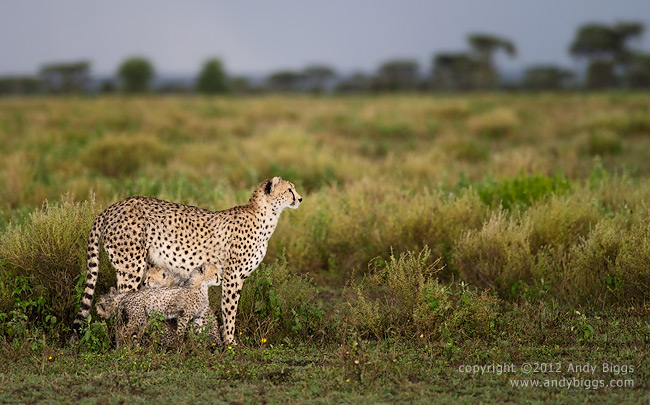
Today was our last full day in the greater Serengeti ecosystem at a place we call Ndutu, and it was one of the most photgraphically rich days we have had on the safari. Read on!
Just outside of camp we stopped for bat-eared foxes, and unlike most I have photographed in the past the 5 individuals were curious about us and didn’t run away. Typically they are quite shy and skiddish, and these were a welcome sight for me, as I don’t have enough quality photos of them.
Cheetah were next on our sighting list, and we watched 2 adult males walk the swamp edges for more than an hour. With a respectful distance, we watched them jump across water, play with each other and rest when they needed to rest. It was a great hour of entertainment, and the highlight was watching them both drink at the water’s edge with their eyes looking our direction. Oh, and their reflection in the water was the icing on the cake.
When they sat down to rest in the shade, we waited for 30 minutes to see if they would give us another show, but it appeared to be it for a while. We moved back to the main area of the swamp, and located the lion pride with the 3 cubs again. They were happy to be sleeping, so within minutes we found our next photo op that would last the remainder of the morning: zebras at a watering hole.
We photographed zebras coming and going in and around a large watering hole, and every few minutes a group would get spooked and would run through the water back to the safety of dry land. What great photos can be had in these situations, and it takes patience to get the right shots. I think I burned 10gb of memory in 1 hour, which is a significant burn rate for me. I just don’t shoot that many images, and I had to seize the opportunity.
After our lunch and midday rest, Troy and I spent a few minute shooting video testimonials from some of our travelers, as well as short interviews with the guides. Troy is shooting all of the video, and I am just acting as producer / interviewer. We did bring along high quality Sony wireless lav microphones, which really helps with the production quality. Audio quality is very very important!
We found a pride of 9 adult lions out on the open plains, who were seeking shade underneath a large acacia tree. Not much happened, but we were able to shoot some 60p slo-mo video of lions yawning, which may turn out to be interesting to see. After a little while we moved on and saw another 2 adult male cheetahs. They were extremely skiddish, and we left within a few minutes, as they weren’t interested in being near us.
On the way back into the acacia woodland near Lake Masek, we watched 2 adult male giraffes fighting. I have seen many many sparring giraffes, however this scene was an aggressive fight that could not be considered sparring. Male giraffes yse their necks and heads to deliver blows to each other, and timing the best time to take photographs can be tricky.
A short trip around Lake Masek followed, and we stopped a few places to shoot the flamingoes in the warm afternoon light.
 Sunday, April 1, 2012 at 02:35PM
Sunday, April 1, 2012 at 02:35PM 
 Ndutu,
Ndutu,  Serengeti,
Serengeti,  Tanzania,
Tanzania,  safari in
safari in  Photo of the Day
Photo of the Day 


